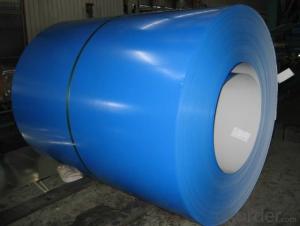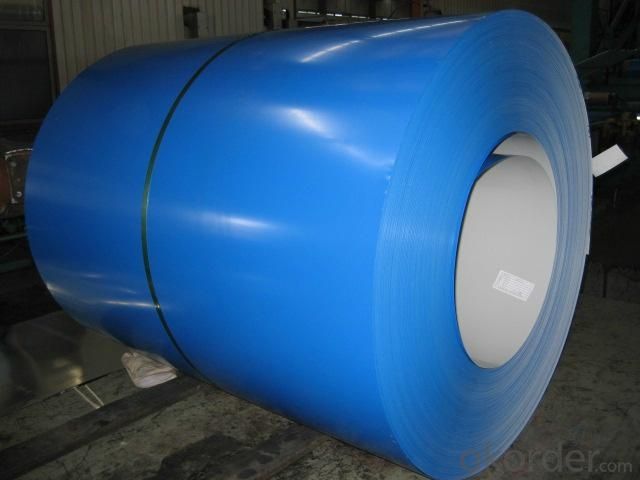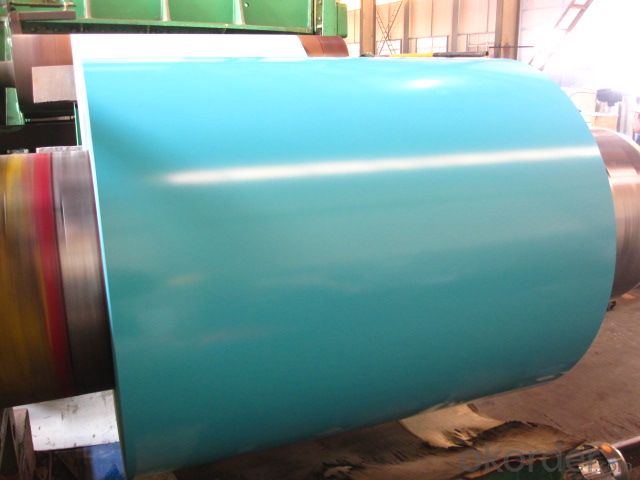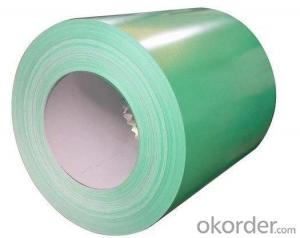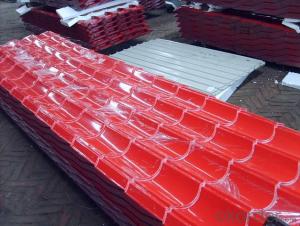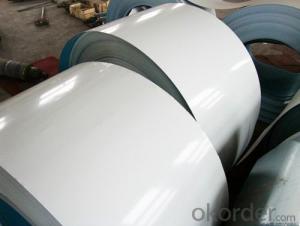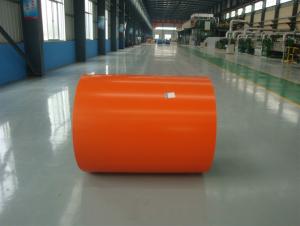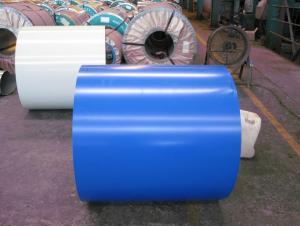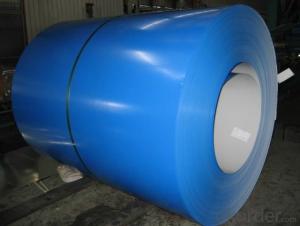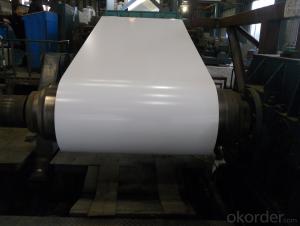PRE-PAINTED ALUZINC STEEL COIL WITH HIGH QUALITY
- Loading Port:
- Shanghai
- Payment Terms:
- TT OR LC
- Min Order Qty:
- 50 m.t.
- Supply Capability:
- 5000 m.t./month
OKorder Service Pledge
OKorder Financial Service
You Might Also Like
Painting steel is the product based on the metal sheet, of which surface is finally installed of the plastic film(PVC, PE) IN addition to being firstly covered with the coating and printed ink in. The coated layer of painting steel plate consists of chemical and filming layer, primer coated layer, pattern printed layer and surface coated layer. The top and back coating shall generally be the weatherproof paint, as well can be the application of the paint with special capabilities such as stain-resistant, self cleaning capability, high thermal resistance, antistatic capability, sterilizing capability, finger-print prevention and etc.
With GI(aluzinc) as base metal, after pretreatement(degrease and chemical treatment)and liquid dope with several layers of color, then after firing and cooling, finally the plate steel is called pre-painted galvanized (aluzinc)steel. Pre-painted galvanized steel is good capable of decoration, molding, corrosion resistance. It generally displays superior workability, durability and weather resistance.
Available specification:
PAINTING STEEL | |
BASE MATERIAL | HDGI, ALUZINC,CR |
GRADE | SGCC, DX51D,ASTMA653,EN10142,S350GD |
THICKNESS | 0.17-1.0mm |
WIDTH | 600-1250mm |
ZINC COATING | 60-200g/㎡ |
PAINT | PE,PVDF,SMP,HDP |
COILED | 508mm |
COIL WEIGHT | 3-6mt |
We can supply customers' with different specifications of the highest quality and lowest price.
Sincerely welcome to contact us for the future details if any item interest you ,and we will make every effort to assure that your requirements will be satisfied ,and we hope to establish long-term business relations with you on the basis of the equality and mutual benefit.
We are waiting for your email.
- Q: What are the different types of steel coil packaging techniques?
- There are several types of steel coil packaging techniques, including banding, strapping, shrink wrapping, and palletizing. Banding involves securing the coil with metal bands, while strapping uses plastic or steel straps. Shrink wrapping involves wrapping the coil with plastic film and applying heat to shrink it tightly. Palletizing involves stacking the coils on a pallet and securing them with stretch wrap or straps. These techniques help protect the coils during transportation and storage.
- Q: How are steel coils inspected for thickness?
- Steel coils are inspected for thickness using a non-destructive testing method called ultrasonic testing. In this process, high-frequency sound waves are transmitted through the coil, and the time it takes for the waves to bounce back is measured. This allows for precise measurement of the thickness of the steel coil, ensuring it meets the required specifications.
- Q: How are steel coils used in the production of steel clips?
- Steel coils are used in the production of steel clips by being fed into a stamping machine, which cuts and shapes the coils into the desired size and shape of the clips.
- Q: How are steel coils used in the production of steel pipes?
- Steel coils are an essential component in the production of steel pipes. These coils serve as the raw material that is used to manufacture the pipes. The first step in the process involves unwinding the steel coil and feeding it into a machine called a slitter. The slitter cuts the coil into narrower strips of the desired width. This width is crucial as it determines the diameter of the steel pipes that will be produced. Once the steel coil has been slit into strips, the next step is to feed these strips into another machine called a forming mill. The forming mill gradually shapes the strips into a cylindrical shape by passing them through a series of rollers. These rollers apply pressure and bend the strips until they take on the form of a pipe. To ensure the durability and strength of the pipes, they undergo a welding process. The ends of the strip are heated and fused together using a high-frequency electric current, resulting in a continuous weld along the length of the pipe. This weld provides structural integrity and prevents any leakage or weak spots in the pipe. After the welding process, the pipes go through a sizing and shaping process. They are passed through additional rollers and gradually reshaped to achieve the desired dimensions, including the final outer diameter and wall thickness. Finally, the pipes are cut to the desired length and undergo various finishing processes such as straightening, testing, and coating. These finishing steps ensure that the pipes meet the required specifications and are ready for use in various applications, such as plumbing, construction, and oil and gas industries. In summary, steel coils are the starting point for the production of steel pipes. They are slit, formed, welded, sized, shaped, and finished to create durable and high-quality pipes that can be used in a wide range of industries.
- Q: A roll of 1 meters wide color steel roll about how many tons?
- Color steel roll is a composite material, both steel and organic materials, both of them a little. Both the mechanical strength of steel plate and easy molding performance, but also organic materials, good decoration, corrosion resistance. 1 meters wide should also have length, wall thickness conditions to know how many tons. The manufacturer is generally in accordance with customer requirements into a volume, the normal width of 1 meters per roll over 1 tons.
- Q: What are the common defects in steel coil finishes?
- Steel coil finishes can be affected by various defects that can impact both their appearance and functionality. Before using or selling the coil, these defects may need to be addressed. One common defect is coil breaks, where the steel strip breaks during winding or unwinding. If not dealt with, this defect can cause a discontinuity in the coil's surface and potentially lead to further damage. Another defect is edge wave, which refers to a distortion or waviness at the edges of the coil. This can occur during the rolling or cooling process and can affect the coil's flatness and uniformity. Corrosion is another issue that can arise if steel coils are not properly protected or stored. This can result in rust and degradation of the steel, impacting its strength and appearance. Streaks and stains can appear on the surface of steel coils due to improper cleaning or contamination during production. These defects can affect the aesthetic appearance of the steel and may need to be addressed before use. Scratches and dents can occur during handling, transportation, or storage of steel coils. These defects can impact the flatness and surface quality of the steel and may require repairs or adjustments. If a coating or paint is applied to the steel coil, several defects can arise, including blistering, peeling, or uneven application. These coating defects can affect the durability and appearance of the steel. It's important to note that the severity of these defects can vary, and different methods of repair or mitigation may be needed. Regular inspections and quality control measures can help to identify and address these defects before they become more significant issues.
- Q: Can steel coils be used in structural applications?
- Yes, steel coils can be used in structural applications. Steel coils are widely used in the construction industry for various structural applications such as building frames, bridges, and infrastructure projects. The coils can be processed and formed into different shapes and sizes to meet the specific requirements of the structure, providing strength, durability, and structural integrity.
- Q: How are steel coils used in the production of telecommunications equipment?
- The production of telecommunications equipment commonly involves the use of steel coils, which offer structural support and durability. These coils are utilized to fabricate different components, including cabinets, racks, and enclosures. A significant application of steel coils in telecommunications equipment is seen in the manufacturing of cabinets. These cabinets serve as housing for the delicate electronic components and wiring utilized in telecommunications systems. Steel coils are typically shaped to form the cabinet structure, providing a robust and dependable enclosure for the equipment. The steel material also offers protection against external factors such as impacts, dust, and moisture, ensuring the longevity and integrity of the telecommunications equipment. Steel coils also find application in the production of racks for telecommunications equipment. These racks are designed to organize and provide accessibility to multiple devices, including servers, switches, and routers. The strength and rigidity of steel coils make them an ideal material for constructing these racks, ensuring they can bear the weight of multiple devices and withstand the constant handling and movement that occur in telecommunication environments. Moreover, steel coils are used to manufacture enclosures for telecommunications equipment. These enclosures act as protective casings, safeguarding sensitive electronic components from external influences such as electromagnetic interference and physical damage. Steel coils are often formed into specific shapes and sizes to create these enclosures, providing a sturdy barrier that shields the equipment from various external threats. In conclusion, steel coils play a crucial role in the production of telecommunications equipment by offering structural support, durability, and protection. They are employed in the creation of cabinets, racks, and enclosures, which ensure the proper functioning and longevity of the sensitive electronic components used in telecommunication systems.
- Q: What are the different methods of edge wave correction for steel coils?
- Steel coils often experience edge waves, which are deformations along the edges. To address this issue, various methods are commonly employed. One frequently used technique is edge wave flattening. This involves applying pressure to the coil's edges using hydraulic or mechanical devices. By doing so, any waves or deformations are effectively flattened out. Edge wave flattening can be performed during the coil processing stage or as a separate step after production. Another approach is edge trimming, where the coil's edges are trimmed or cut to remove waves or deformations. Mechanical shearing or laser cutting technology can be utilized for this purpose. Edge trimming not only corrects edge waves but also ensures straight and smooth edges. Tension leveling is another popular method. It involves subjecting the coil to tension forces, which stretch and flatten any waves or deformations. Tension leveling is typically performed during the processing stage and is effective in correcting both edge waves and other surface defects. Roll leveling is also effective for correcting edge waves. This method utilizes a set of rolls to gradually apply pressure to the coil, resulting in the flattening of waves or deformations. Roll leveling is a versatile technique that can address various types of coil defects, including edge waves. Furthermore, advancements in technology have led to the development of automated edge wave correction systems. These systems employ sensors and computer algorithms to detect and correct edge waves in real-time during the coil processing stage. This method ensures precise and consistent correction, reducing the need for manual intervention and improving overall efficiency. In summary, the methods for correcting edge waves in steel coils include edge wave flattening, edge trimming, tension leveling, roll leveling, and automated correction systems. Each method offers unique advantages and can be chosen based on the specific requirements and constraints of the coil processing operation.
- Q: How are steel coils manufactured?
- Steel coils are manufactured through a multi-step process that involves heating and shaping steel slabs, followed by passing them through a series of rolling mills to reduce their thickness and increase their length. The coils are then cooled, inspected for quality, and finally, wrapped and ready for shipping.
Send your message to us
PRE-PAINTED ALUZINC STEEL COIL WITH HIGH QUALITY
- Loading Port:
- Shanghai
- Payment Terms:
- TT OR LC
- Min Order Qty:
- 50 m.t.
- Supply Capability:
- 5000 m.t./month
OKorder Service Pledge
OKorder Financial Service
Similar products
Hot products
Hot Searches
Related keywords
